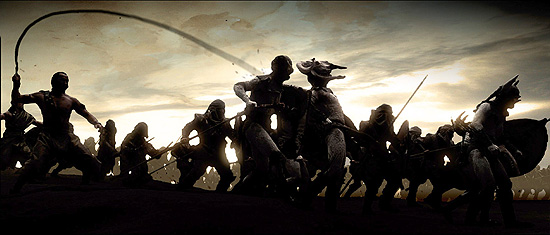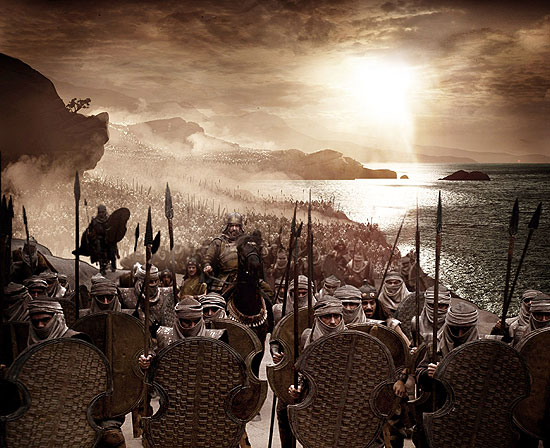
It’s December 2005 and I’m watching oily half-naked men swing swords around. No, I am not at Garth Franklin’s latest party – it’s the set of 300, Warner Bros’ adaptation of Frank Miller’s graphic novel take on the Battle of Thermopylae, where 300 Spartans held off maybe a million or more Persians, saving Greece and paving the way for modern civilization and quite possibly NAMBLA.
300 is shooting in Montreal (Canada, for those of you who slept through geography), and it’s so cold that I find myself wishing for catastrophic global warming to start immediately (my wish would come true a year later). Flying into the city I was full of conflicted feelings – while I liked director Zack Snyder’s Dawn of the Dead remake well enough, I wasn’t sold on shooting a battle epic on a Canadian soundstage. And the cast wasn’t exactly blowing me away, either – not that there’s anything wrong with people like Gerard Butler and David Wenham, I just don’t view them as the kind of guys who sell a movie.
But of course it isn’t their names selling the movie – it’s the incredible visuals. None of which would be on display on the set visit, as the movie is shot completely in front of blue screens, giving everything a “fucking around in your basement” quality when you’re on set. If all I saw while in Montreal was the naked men and the big blue sheets, I might have come home feeling very pessimistic about the whole thing, but that wasn’t all we saw. Snyder showed us the demo reel that had sold Warner Bros on his style and take on the material, and it sold me as well.
Set visits are usually less exciting than you would imagine. Often a studio will fly you halfway around the world to watch people standing around for hours and then finally get to see a few minutes of boring, repetitive nonsense in front of the cameras. When I went to see the Aeon Flux set I was flown to Berlin just to watch Charlize Theron do some kind of hand movement again and again in front of a green screen. Over the summer I was sent to Mexico City to spend an hour or so watching an actress sit in the cab of a truck in front of a green screen while guys shook the chassis to give the illusion of movement. This is, without a doubt, a fair representation of the strangely monotonous work that goes into making exciting movies, but it doesn’t give you much to write about.
The 300 set visit is not like that. We see thirty Spartans clashing with thirty Persians, and one guy takes a sword so hard to the gut that he flips in the air (assisted by a wire, of course). We see a wall made of corpses. We see a massive animatronic wolf. We see a very realistic dead horse. We see scars, weapons, and we eat lunch next to guys dressed like the Persian monsters called The Immortals. At one point I notice that a prop skull has brains inside of it. This is a good set visit.

300 is filming just outside of Montreal in a soundstage that is like an airplane hangar. This is one of the most interesting things about visiting a set – how tall the buildings are. Escorted by some wonderful friends from Warner Bros publicity (one of whom will, later that night, be spitting cherry stems at hotel bar hookers) we escape the bitter Canadian cold and step into the massive building. We go up some very slippery metal stairs, and to our right is arrayed a vast armory of rubber weapons, which all look completely real up until the moment you hold them in your hand. We’re led through the production offices – we pass editing suites, and to our left is a row of windows overlooking some of the sets. We see a Persian set in the making – huge elephant tusks form the skeletal structure of what will eventually be a massive tent. Our group, made up of a motley crew of print and online journalists (including a couple of old friends like internerds Dan Epstein and Ed Douglas, and new friends like Empire writer Helen O’Hara), gets situated in the conference room.
It’s here that we get our first glimpse of what 300 could be. There is a cork board with a series of images – first there’s Frank Miller’s original art from the 300 graphic novel, then a storyboard version, then the actual shot from the set, with the actors standing around on a green screen stage. But there’s a final shot for these, and it’s the “crush” shot. The crush is a computer process that I can’t explain to you (God knows they try to explain it to me, but I am still mystified by PhotoShop filters), but if you’ve seen the trailers or images released so far you know what it does – it makes the film look like a painting. In fact, there’s quite a while where we’re unsure whether these final images are from the movies or painted representations of what they want to achieve. Shit is that good.
After losing our coats and claiming our seats at the conference table (claiming seats at roundtables is part of the inherent skillset anyone wishing to do junkets or set visits must have), our tour begins in earnest. First stop: the armory at the bottom of the stairs. I have to admit that I sort of drift away from the group here, as I quickly discoverthe skull with the brains in it and need to show it to everyone. The sheer array of weapons is impressive, though, and many of them have been created just for the film. Others are recycled from Troy and Alexander, which actually makes me a little giddy. Even with a number of set visits under my belt, I keep the old-school vision of what a movie set is like in my head, the kind of a vision that you see in so many movies where Roman centurions are eating commissary lunch next to spacemen. The idea of reusing props from film to film fits in nicely with that vision for me.

We next proceed on to the gym. When you have a movie filled with mostly naked Spartan warriors, you can’t fake the physique, and so director Zach Snyder has brought in sadist/trainer Mark Twight. Twight runs a gym that seems to adhere to the Spartan ethic – for the love of God, it’s called Gym Jones. From their website: “Gym Jones is not a cozy place. There’s no AC, no comfortable spot to sit and there are no mirrors. Stressors are intentionally designed to cause discomfort and apprehension. Effort and pain may not be avoided. Physical and psychological breakdowns occur. The support of a like-minded group, dedicated to The Art of Suffering, provides a safety net. An individual will push harder and risk more in the company of trustworthy peers and that’s one reason the gym is not open to the public. Gym Jones is a private, invitation-only facility located in Utah.”
So yeah, this is not your standard on-set trainer who is all about stroking star ego. Dwight’s a madman who trains cage fighters and firemen – guys who need the strength for something more than show. He has the actors drag tires around the on-set gym for hours a day. There are no Nautilus machines here – there are blocks of wood to sit on and big heavy objects to lift and toss. The actors get punished here, just like the real Spartans would have. You have to admire the level of dedication given by everyone to spend hours with the cruel and driven and inspirational Mark Twight, but as a fat slob I can’t wait to get the hell out of the room before he starts demanding push-ups from me while a crippled Pakistani boy sits on my back.
And so ends Part 1. In Part 2 we will visit the special FX department and I will touch a wolf. We will go to the make-up department and see the prosthetics for Ephialtes, the hunchback. We will also visit the costume department, which smells so bad it will move me to the brink of vomiting.
Also coming: interviews with Frank Miller, Zack Snyder and the actors. In fact, let’s start with the lead himself, Gerard Butler, which you can read by clicking here.

.